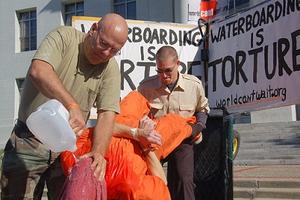CIA torture reportReport details brutal interrogation practices, lax supervision
The long-awaited report on the CIA interrogation practices was release yesterday, causing a political storm. Many congressional Republicans have expressed concern over the release of the Senate report on the CIA’s use of torture on captured al-Qaeda and Islamist militants, claiming it would set off a global backlash, and threaten the security of American troops and diplomatic missions overseas.Obama administration officials agree that the release of the Senate report or its declassified executive summary is a good reason for concern about the security of U.S. facilities and military bases overseas, but they doubt it would lead to the sort of violence that killed four Americans at a diplomatic outpost in Benghazi, Libya in 2012.

Waterboarding demonstration by protestors during a rally // Source: presstv.ir
The long-awaited report on the CIA interrogation practices was release yesterday, causing a political storm. Many congressional Republicans have expressed concern over the release of the Senate report on the CIA’s use of torture on captured al-Qaeda and Islamist militants, claiming it would set off a global backlash and threaten the security of American troops and diplomatic missions overseas. “Foreign leaders have approached the government and said, ‘You do this, this will cause violence and deaths,’ ” said chairman of the House Intelligence Committee Representative Mike Rogers (R-Michigan). “Our own intelligence community has assessed that this will cause violence and deaths,” he added.
Obama administration officials agree that the release of the Senate report or its declassified executive summary is a good reason for concern about the security of U.S. facilities and military bases overseas, but they doubt it would lead to the sort of violence that killed four Americans at a diplomatic outpost in Benghazi, Libya in 2012. That incident, they insist, was fueled by perceived attacks on Islam as a religion than by violence against individuals.
The newspapers’ headlines were unsparing: Here are the headers of four New York Times stories: “Senate Torture Report Faults CIA for Brutality and Deceit”; “Congress and White House Were Misled”; “Disarray and Dissent in CIA Over Interrogation Program”; and “Overseas, Torture Report Prompts Calls for Prosecution.” Here are the headers of three Washington Post articles: “Senate report on CIA program details brutality, dishonesty”; “Bleak verdict on interrogations after Sept. 11”; and “Uncooperative terrorism suspects faced rectal rehydration, feeding.”The Senate report highlights a CIA prison, identified as Cobalt, believed to be in Afghanistan, which housed roughly half of the 119 detainees identified in the report. The CIA authorized more than $200,000 for the construction of Cobalt in June 2002, and it held its first detainee, Ridha al-Najjar, in September 2002. At the site, detainees were subject to sleep deprivation,shackled to bars with their hands above their heads, forced rectal feeding, and intense water boarding. At one point, al-Najjar was hung by handcuffs and not allowed to lower his arms for twenty-two hours each day for two consecutive days. In another case, detainee Gul Rahman had his clothes ripped off, as CIA interrogators slapped, punched, and later dragged him along a dirt floor. He was later found dead, with hypothermia as the suspected cause.
Detainees “could go for days or weeks without anyone looking at him,” said one senior interrogator mentioned in the report, whose team discovered a detainee had been chained in a standing position for seventeen days, “as far as we could determine.”
The Daily Beast reports that the mismanagement and abuse at Cobalt can be traced in part to a CIA officer identified in the Senate Intelligence Committee’s report as “CIA Officer 1.” This particular officer had no interrogation experience, and his leadership was questioned by fellow CIA officers due to his “lack of honesty, judgment and maturity.” He continued as the head of Cobalt until July 2003.
In December 2002, a CIA Renditions Group visited Cobalt and asked for a review of the interrogation process and prison conditions, as well as a legal review, but there is no evidence that the CIA approved the request. In interviews conducted in 2003 with the CIA Office of Inspector General, top CIA leadership and attorneys acknowledged that they had little information on operations at Cobalt. In August 2013, CIA General Counsel Scott Muller, said he was “not very familiar” with Cobalt and that he believed Cobalt was just a holding facility.
The New York Times points out that one of the most alarming points in the Senate report is the conclusion that the CIA’s interrogation techniques failed to yield worthwhile intelligence about imminent terrorist attacks. Information gathered via CIA interrogation tactics were already available to the intelligence community from other sources including law enforcement agencies, communications intercepts, and other surveillance reports. “When you put detainees through these (torture sessions) they will say whatever they can say to get the interrogations to stop,” a Senate aide told the Daily Beast. The Senate report describes the tactics used at Cobalt and other CIA prisons as “discredited coercive interrogation techniques such as those used by torturous regimes during the Cold War to elicit false confessions.”
So, despite multiple requests from Republican lawmakers to not release the Senate report, President Barack Obama “believes it is important for us to be as transparent as we possibly can about what exactly transpired, so we can just be clear to the American public and people around the world that something like this should not happen again,” White House press secretary, Josh Earnest, told reporters.
